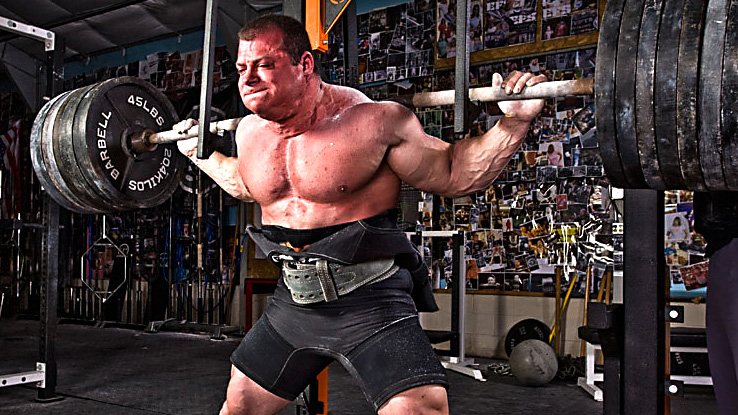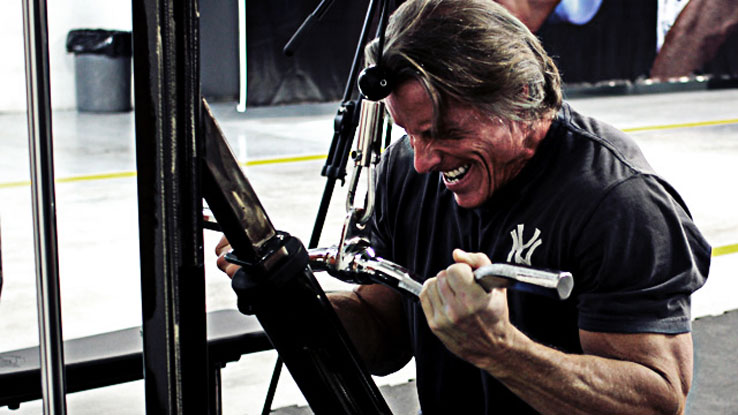Having big, broad shoulders is a symbol of power that everyone recognizes. Everyone wants to look more powerful, so it stands to reason that practically everyone, male or female, wants big, round, full deltoids. Even fashion designers know this, which is why you see padded shoulders in suits, coats, and even shirts: it's so that even little skinny people can look powerful.
Besides the obvious benefit of making you look and feel powerful, another huge plus of well-developed deltoids is the fact that they make your waist appear narrower, another thing everyone wants, with the possible exception of sumo wrestlers.
This optical illusion is exactly why, if you're a bodybuilder or a figure competitor, there's no such thing as deltoids that are too big. Competitors that look the best from the front are typically those that have big, wide shoulders.
Think about it: a V-taper is created by the contrast in width of your shoulders to your waist, also called the shoulder-to-waist ratio. The greater this ratio, the more accentuated the V-taper. While you can't alter the distance between your iliac crests without major surgery, you can certainly add muscle to your deltoids.
The Dynamic Deltoid Duo
To help you add some lean beef to your deltoids, I've dug into my bag of tricks, and pulled out two shoulder-blasting supersets. I didn't just make these up, thinking they'd make for a cool article, by the way. They've been proven to work.
By proven, I don't mean proven in some sterile exercise physiology lab to work on hungover undergrad students. I mean proven to work in real gyms on hard-training individuals doing real programs. Many a guinea pig (...er, I mean client) has felt the pain, and enjoyed the benefits of these exercise combos.
If you're not afraid to work hard and leave it all on the gym floor, then I encourage you to give these a try. If you don't like to train with animal-like intensity, then you're on the wrong website, my friend. Enjoy your narrow, frail shoulders as best you can. For everyone else, let's get to it.
The Killer Delt Complex
We'll get the party started with my Killer Delt Complex. I'll let Eric B, one of my clients, let you know how it feels.
"This is the first time I've ever felt like I was gonna puke while training shoulders."
Couldn't have said it better myself.
This complex is great for deltoid hypertrophy, and also has the added benefit of improving overall power or "speed-strength." It hits not only all three of the deltoid heads, but also the trapezius, rhomboids, and the external rotators.
I came up with this complex last year after being trained in the Olympic lifts by renowned strength coach Robert dos Remedios. While I have been a CSCS for years and already knew how to do Olympic lifts, I'm humble enough to realize that they aren't my strongest point.
Besides, when you have the opportunity to learn from someone who's world class in their field, you take it, no matter how good you think you are.
Right after training with Coach Dos, I was talking with Alwyn Cosgrove about complexes, or supersets, as we bodybuilders call them. We began brainstorming on how complexes may be of benefit to bodybuilders.
(If you had told me two years ago that I would be talking bodybuilding with Cosgrove, and that the talk would actually help enlighten me, I probably would've fallen out of my chair laughing. Or maybe I would've punched you, depending upon my mood.)
So while you're doing the Killer Delt Complex and cursing my name, don't forget to also curse Dos and Alwyn, as they unknowingly helped me come up with it.
Killer Delt Complex
- Snatches 3 x 5-10
- Clean and press 3 x 5-10
- Cleans 3 x 5-10
- High pulls 3 x 5-10

Hanging snatch, start position

Hanging snatch, midpoint

Hanging snatch, end position

Hanging clean and press, start position

Hanging clean and press, midpoint

Hanging clean and press, end position

Hanging clean, start position

Hanging clean, end position

High pull, start position

High pull, end position
- After a light warm-up (or two, if you feel like you need it), perform three rounds of this complex.
- Select a weight that's tough to do. You should barely be able to complete the last rep of each exercise with good form.
- All of the exercises in this complex are done from the hanging position (bar just below your knee at about the level of the tibial tuberosity).
- Do not rest between the four exercises.
- Rest about two minutes between each round of the complex.
- Use a snatch grip (meaning a wider grip) on the snatches. Then, without putting the bar down, bring your hands in a bit to get a clean (meaning narrower) grip.
- For a different stimulus and more of a conditioning effect, take the reps up to 10 on each exercise. In case you're wondering, the answer is yes. This is pure hell.
- On the snatches, make sure to get the bar back behind you a bit in the overhead position. When viewed from the side you should be able to see your ears; your upper arm is behind them.
- When doing the cleans and high pulls, make sure to lead with your elbows on the way up. Avoid doing a reverse curl.
The Delt Triad
Now let's move on to a superset that's less power-oriented and more like a traditional bodybuilding superset: the Delt Triad.
I have no thrilling stories about working with world-renowned coaches here. I came up with this one about a decade ago after reading a training article about some pro bodybuilder's shoulder workout. He did a dumbbell tri-set, but not in the proper order to match one's natural strength on the given exercises.
I created this superset such that you do the most difficult exercise first, then the next most difficult, followed by the easiest. As you'll see, dumbbell presses aren't so easy when your medial and anterior delts are already toasted.
DeltTriad
- Lateral raises 3 x 12-15
- Front raises 3 x 12-15
- Dumbbell press 3 x 12-15

Seated lateral raise, start position

Seated lateral raise, end position

Seated front raise, start position

Seated front raise, end position

Seated dumbbell shoulder press, start position

Seated dumbbell shoulder press, end position
- Perform each of the three exercises back-to-back with no rest.
- Rest about 90 seconds before each round of the triad.
- Select a weight that allows you to only get 12-15 reps of lateral raises with good form. Then dig deep and get the same number of reps (with the same weight) on each of the next two exercises.
- Yes, you will feel like a puss on the dumbbell presses.
- While you can certainly do the triad standing, I typically have people do it seated. I'm sure the "functional training" police will be all over me for suggesting this, but the goal here is to isolate the deltoids, as opposed to simply using more weight.
- Lateral raises in particular are hard for most people to do in such a manner that they place the stress squarely on the medial delts, as opposed to letting the stronger anterior delts and upper traps take over the movement.
- To optimally hit the medial delts with lateral raises, avoid letting the upper traps shrug your shoulders up. Likewise, lean forward at the waist a few degrees, and make sure that your shoulder, elbow, and wrist are level at the top of the movement.
- Another trick to keeping the stress on the medial delts is to keep the pinky side of the dumbbell slightly higher than the thumb side. This creates a slight internal rotation of the humerus, and keeps you from externally rotating, which shifts some of the emphasis to the anterior deltoid.
- Because peak contraction of the anterior deltoid is not reached until about 110° of shoulder flexion, bring the dumbbell up to about forehead level on the front raises.
How to Implement
As a general rule of thumb, you don't want to focus on trying to bring up more than one (or two, in some instances) body part per training cycle. Sure, you want your whole body to grow each cycle, but your emphasis should be on just one or two lagging body parts.
If you're going to partake in either of the above delt destroyers, then let's assume shoulders are a body part you'd be focusing on. With that understanding, do a more conventional training program for other body parts while implementing the above two.
As luck would have it, these two programs are very different from one another. The Killer Delt Complex focuses on power via quick movements, heavy weight, and low reps, while the Delt Triad focuses more on hypertrophy and isolation by using precise movements and higher reps with a relatively lighter weight.
Because of the unique nature of each, they go very well together in one program. For example, do the Killer Delt Complex on Monday and the Delt Triad on Thursday.
Assuming you keep the rest of your program fairly moderate, you could use these with virtually any type of workout, whether that be full body or body part split.
As an example, here's how I might implement these into a bodybuilding type routine.
- Monday: back and shoulders (using the Killer Delt Complex)
- Tuesday: quads and abs
- Wednesday: off
- Thursday: chest, shoulders (using the Delt Triad), and triceps
- Friday: hamstrings, biceps, and abs
- Saturday: off
- Sunday: off
That's it for now, my friend. Now get busy building some massive delts!





